Go to Iceland bird tour page | European bird tours | European trip reports| All our birding tours
17-25 June 2022
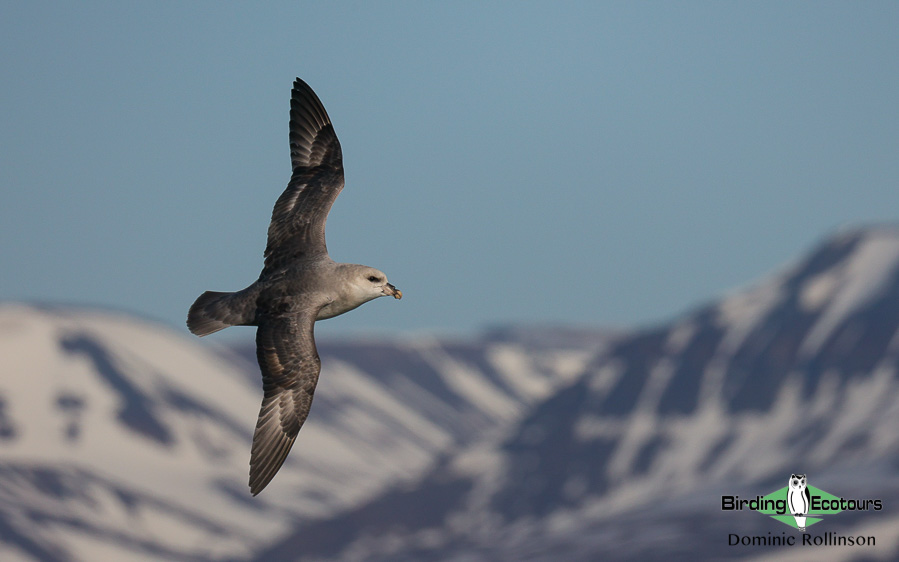
Northern Fulmar were ever present along the coastal regions of Iceland.
Overview
Our nine-day tour of Iceland saw us cover the entirety of the west and north of this beautiful island. Despite bad luck with the weather, which gave us only two days of ideal conditions, we were able to record 69 species, with highlights including Pink-footed Goose, Barrow’s Goldeneye, Harlequin Duck, Ring-necked Duck, Lesser Scaup, Short-eared Owl, Great Skua, Rock Ptarmigan, Thick-billed Murre (Brunnich’s Guillemot), Red-necked Phalarope, Iceland Gull, Glaucous Gull, Northern Wheatear, and Snow Bunting. We also enjoyed good views of Humpback Whale on our whale watching trip.
I would like to thank Steve, Peter, and Frayda for their company on this trip.
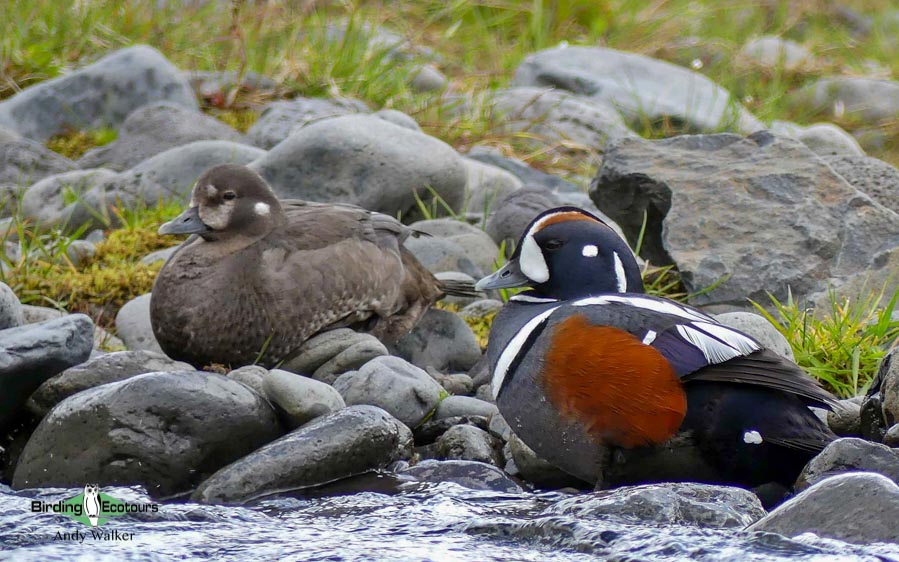
The timing of our tour meant many Harlequin Duck had moved to the coast, allowing us to enjoy some great views.
Detailed Report
Day 1, 17th June 2022. Route to the Snaefellsnes Peninsula
Our first day of the tour was very much a travel day as we headed up the west coast of Iceland towards the Snaefellsnes Peninsula. With inclement weather we made a couple of birding stops along the route in the remote farming areas of the west coast.
Here we saw a number of common Icelandic species including Common Redshank, Parasitic Jaeger (Arctic Skua), Black-tailed Godwit, European Golden Plover, Whooper Swan, Arctic Tern, and Black-legged Kittiwake.
We also enjoyed some of the more special species of Iceland, including Glaucous Gull, Red-throated Loon (Red-throated Diver), and Red-necked Phalarope.
After a long day we retired to our hotel, hopeful that the following day’s weather would prove better.
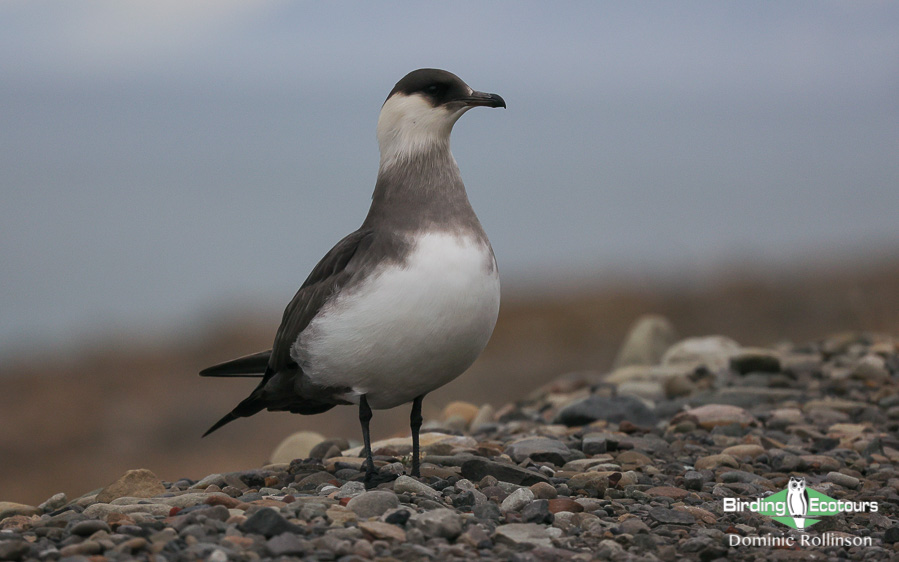
Our first of many Parasitic Jaeger (Arctic Skua) showed superbly in the coastal area of western Iceland.
Day 2, 18th June 2022. Birding Snaefellsnes Peninsula
Today we would explore the beautiful Snaefellsnes Peninsula in glorious weather. Our first stop was the striking waterfall at Kirkjufellsfoss. Not only was the scenery spectacular but we also scored our first Harlequin Duck of the tour. Continuing along the north side of the peninsula we enjoyed good views of Common Eider, Red-breasted Merganser, Tufted Duck, and Greater Scaup in roadside lakes. The best was yet to come, with stunning views of no less than 27 Harlequin Duck in a roadside waterway at Kirkjufellsfoss, an amazing result. After a quick pit stop, we pulled over to check a group of gulls and enjoyed great views of impressive adult Glaucous Gulls on the cliff tops.
Continuing our drive, we came across an Arctic Tern colony at Rif before heading west to the lava fields near Svortuloft Lighthouse. The seabirds here put on a great show with Common Murre (Common Guillemot), Thick-billed Murre (Brunnich’s Guillemot), Razorbill, Black-legged Kittiwake, Northern Fulmar, and Glaucous Gull all performing well. In the lava field nearby, we had brief views of Northern Wheatear and Meadow Pipit.
We then headed to the south of the peninsula and after lunch we attempted to locate a recently seen King Eider at Stadarsveit. Sadly, we had no luck finding it but did locate a flock of Eurasian Wigeon, Black-headed Gulls, plenty more Common Eider, and had close views of Common Redshank and Eurasian Oystercatcher. On the beach distant views were had of both Grey Seal and Harbor (Common) Seal.
After a long but exciting day we headed back to our hotel for the evening.
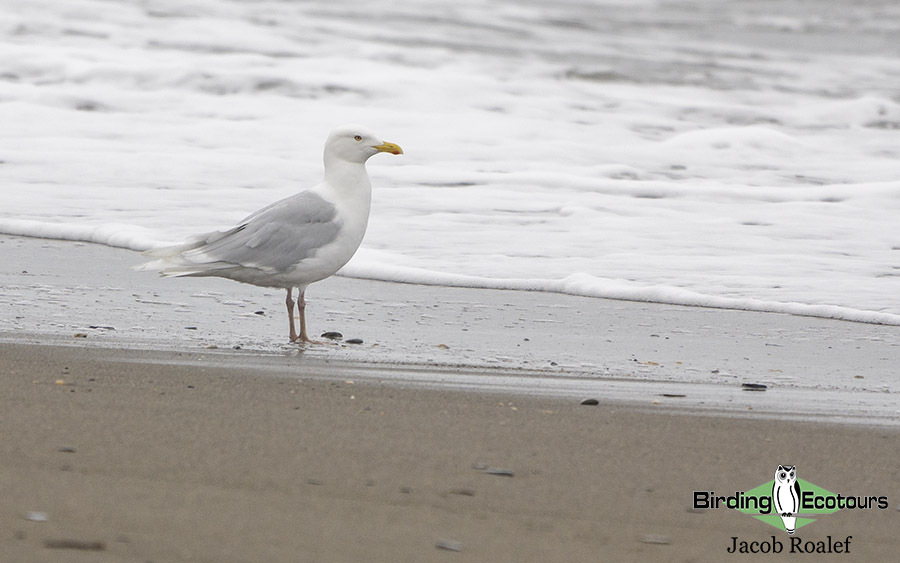
The brutish, but striking, Glaucous Gull was never far away in coastal areas, with a mix of ages on show.
Day 3, 19th June 2022. Journey to the Westfjords, visit to Latrabjarg
Unfortunately the weather turned against us today and hastily rearranged plans meant we would drive from Snaefellsnes to the Westfjords rather than take the boat to Flatey Island. Due to the weather our journey was mostly birdless, save for four Harlequin Ducks close to the road.
After lunch, and with the weather still very poor, we headed to the seabird colony at Latrabjarg. Here we enjoyed amazing views of Atlantic Puffin and had good fly-past views of Parasitic Jaeger (Arctic Skua), Black-legged Kittiwake, Northern Fulmar, Common Murre (Common Guillemot), Razorbill, European Shag, Great Cormorant, and Glaucous Gull.
In the carpark at the colony, we had brief views of Snow Bunting, before enjoying better views of another individual later on. Along the route back to our hotel we also had good views of Common Snipe and some of the group had brief fly-past views of our first Iceland Gull.
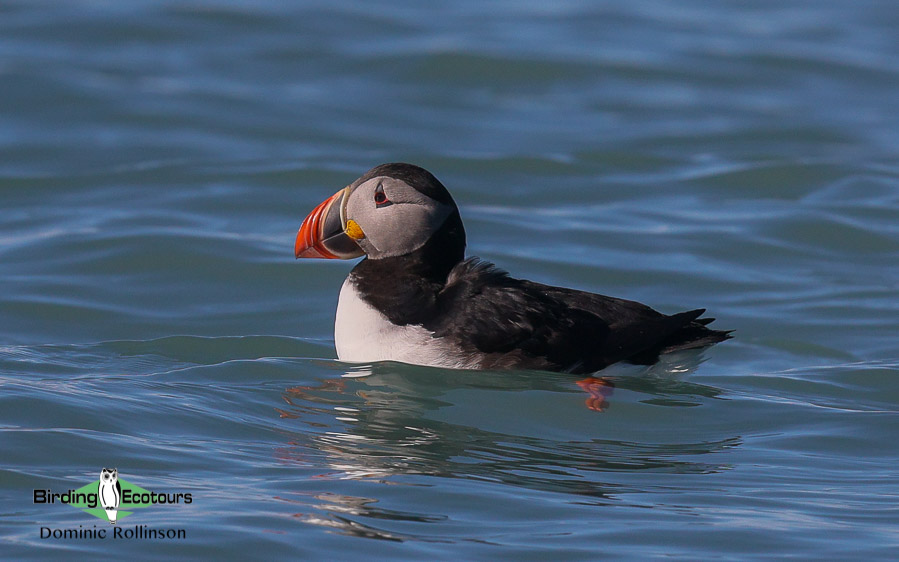
We had enjoyable encounters with the gorgeous Atlantic Puffin at Latrabjarg.
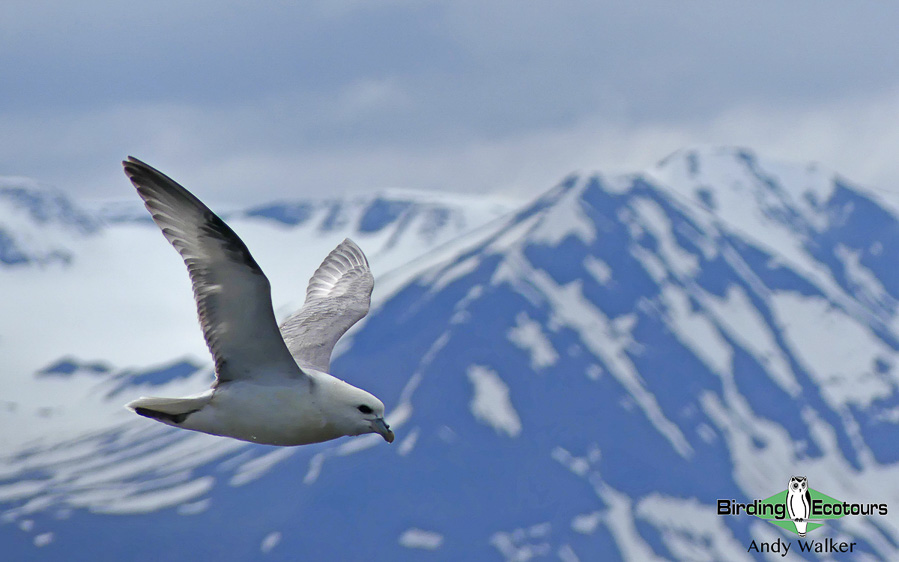
We felt the full force of Arctic weather during our time in Iceland. This made birding difficult but did give for some incredible photographic opportunities with birds such as Northern Fulmar.
Day 4, 20th June 2022. Westfjords, Flatey, journey to the north coast
We started today with a drive up into the Westfjords near Dynjandiá. This wild and beautiful area is remote and vast and our first stop at a small lake gave us good views of both Long-tailed Duck and Common Loon (Great Northern Diver). We continued on to the massive Dynjandi waterfall, which was breathtaking. the nearby Arctic Tern colony was very active, with the terns keen to buzz anyone who came too close.
We next headed back to the coast to catch the boat to Flatey Island. In beautiful conditions we explored this small island with wonderful views had of Red-necked Phalarope, Snow Bunting, Northern Fulmar, Common Eider, and many other species.
After getting back to the mainland we faced a long drive through the evening to the northern part of Iceland. This was breathtaking and en route we enjoyed Rock Ptarmigan, Common Merganser, and other species under the midnight sun.
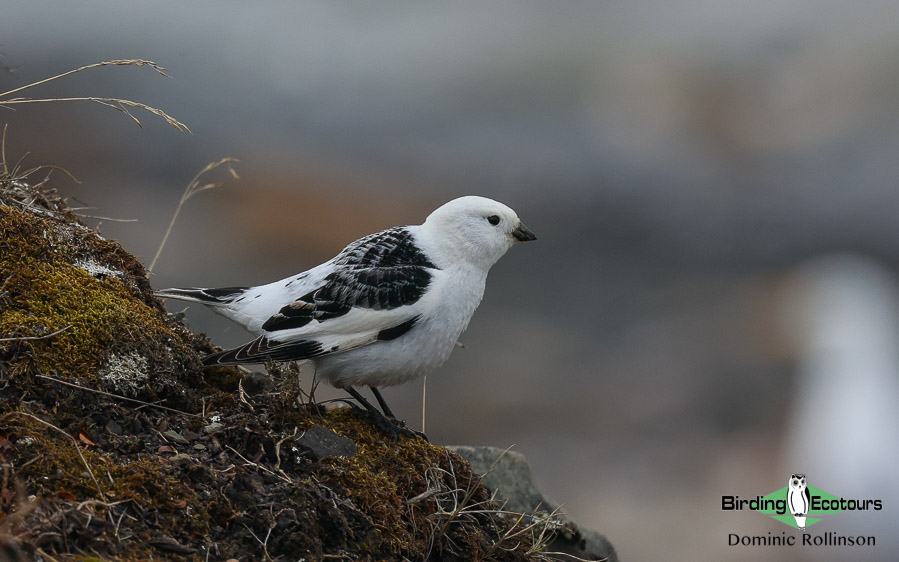
Snow Bunting were a real group favorite on Flatey Island, with many males singing and giving fantastic views.
Day 5, 21st June 2022. The north coast and Lake Myvatn
Today it was time to head to Lake Myvatn, one of Iceland’s most famous birding areas. On our journey to the lake we enjoyed great views of Pink-footed Goose near Kúskerpi and brief but enjoyable views of Short-eared Owl at Laugar.
Once at Myvatn we explored the perimeter of the lake under darkening skies. Great views were had of Barrow’s Goldeneye, Harlequin Duck, Long-tailed Duck, Tufted Duck, Eurasian Wigeon, Common Scoter, Common Pochard, Greater Scaup, Common Loon (Great Northern Diver), and others.
Sadly we had to curtail our birding day as torrential rain arrived while searching for the highly desired Gyrfalcon.
Day 6, 22nd June 2022. Hverfjall and Kopasker
Poor weather once again hampered our day’s birding, as a wintery front came through from Greenland. A brief stop to look for Rock Ptarmigan near Hverfjall didn’t give us our desired species, however we did find our first Common Redpoll of the trip, which showed very well.
Moving north towards the coast some of the group had a brief Merlin flyover the car. With the weather closing in we stopped at some roadside ponds near Kópasker and had brief views of Horned Grebe (Slavonian Grebe), Red-throated Diver, and a number of Red-necked Phalarope.
A sheltered harbor at Lón-sudurhluti held Red-breasted Merganser and Common Eider, while a fly-past Great Skua was our first of the trip. Nearby a Rock Ptarmigan showed briefly and once again we enjoyed great views of Black-tailed Godwit.
After lunch the weather became progressively worse so we decided to retreat to our hotel. Along the route we had brief fly past views of Common Gull.

Common Redpoll was one of just a few passerines we were able to catch up with, but that made them all the more special.
Day 7, 23rd June 2022. Whale watching and the journey south
With poor weather once again present our planned whale watching trip had been moved to a more sheltered location. Despite this the going was very rough and only brief views of Humpback Whale were had, although one did jump clear of the water!
Bird wise, it was also relatively quiet with Black Guillemot and Parasitic Jaeger (Arctic Skua) being the highlights.
After the cold trip we made the four-hour journey south to our hotel.
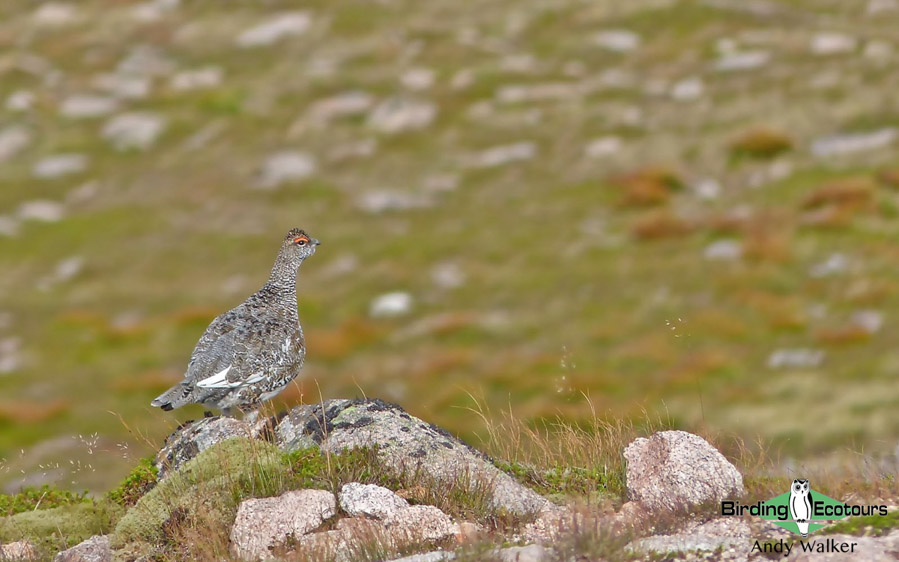
Rock Ptarmigan proved to be an elusive species until the final day.
Day 8, 24th June 2022. The Reykjanes Peninsula
Finally the sun was shining again for us, unfortunately it was accompanied by strong winds from the north, which made birding very difficult once again. Heading south we checked a few sites for some late target species, such as King Eider and White-tailed Eagle. Sadly we were unable to locate either but did add Common Shelduck to our list at Kistufjördur mud flats.
After lunch we headed to Vifilsstadavatn where we were able to observe Ring-necked Duck, Lesser Scaup, Greater Scaup, Horned Grebe (Slavonian Grebe), Common Loon (Great Northern Diver), and Red-necked Phalarope.
Our final stop of the tour was the Reykjanes Peninsula. Exploring its perimeter in the strong winds proved challenging once again, however we did enjoy the Midlina Bridge (The bridge between continents) where one can see the meeting point of the Eurasian and North American tectonic plates.
Moving to the north of the peninsula we scanned the sea and picked up our final two new birds of the tour, Northern Gannet and Manx Shearwater. The sea was very rough but was teeming with sea birds.
Finally, we explored the tundra area near the airport where a Rock Ptarmigan showed amazingly well as did a stunning adult summer-plumaged Iceland Gull, among close to 500 Lesser Black-backed Gulls.
Tired after another testing day with the weather we retreated to our hotel for the final evening.
Day 9, 25th June 2022. Departure
This morning we departed from Keflavik Airport after an enjoyable nine days of Icelandic birding.
Bird List – Following IOC (12.1)
Birds ‘heard only’ are marked with (H) after the common name, all other species were seen.
The following notation after species names is used to show conservation status following BirdLife International: VU = Vulnerable, NT = Near Threatened
| Common Name | Scientific Name |
| Ducks, Geese, Swans (Anatidae) | |
| Canada Goose | Branta canadensis |
| Greylag Goose | Anser anser |
| Pink-footed Goose | Anser brachyrhynchus |
| Whooper Swan | Cygnus cygnus |
| Common Shelduck | Tadorna tadorna |
| Gadwall | Mareca strepera |
| Eurasian Wigeon | Mareca penelope |
| Mallard | Anas platyrhynchos |
| Eurasian Teal | Anas crecca |
| Ring-necked Duck | Aythya collaris |
| Common Pochard – VU | Aythya farina |
| Tufted Duck | Aythya fuligula |
| Greater Scaup | Aythya marilla |
| Lesser Scaup | Aythya affinis |
| Common Eider | Somateria mollissima |
| Harlequin Duck | Histrionicus histrionicus |
| Common Scoter | Melanitta nigra |
| Long-tailed Duck – VU | Clangula hyemalis |
| Barrow’s Goldeneye | Bucephala islandica |
| Common Merganser (Goosander) | Mergus merganser |
| Red-breasted Merganser | Mergus serrator |
| Pheasants & Allies (Phasianidae) | |
| Rock Ptarmigan | Lagopus muta |
| Pigeons, Doves (Columbidae) | |
| Rock Dove (Feral Pigeon) | Columba livia. dom. |
| Grebes (Podicipedidae) | |
| Horned Grebe (Slavonian Grebe) | Podiceps auritus |
| Oystercatchers (Haematopodidae) | |
| Eurasian Oystercatcher | Haematopus ostralegus |
| Plovers (Charadriidae) | |
| European Golden Plover | Pluvialis apricaria |
| Common Ringed Plover | Charadrius hiaticula |
| Sandpipers, Snipes (Scolopacidae) | |
| Eurasian Whimbrel | Numenius phaeopus |
| Black-tailed Godwit – NT | Limosa limosa |
| Ruddy Turnstone | Arenaria interpres |
| Dunlin | Calidris alpina |
| Purple Sandpiper | Calidris maritima |
| Common Snipe | Gallinago gallinago |
| Red-necked Phalarope | Phalaropus lobatus |
| Common Redshank | Tringa totanus |
| Gulls, Terns, Skimmers (Laridae) | |
| Black-legged Kittiwake – VU | Rissa tridactyla |
| Black-headed Gull | Chroicocephalus ridibundus |
| Common Gull | Larus canus |
| Great Black-backed Gull | Larus marinus |
| Glaucous Gull | Larus hyperboreus |
| Iceland Gull | Larus glaucoides |
| European Herring Gull | Larus argentatus |
| Lesser Black-backed Gull | Larus fuscus |
| Arctic Tern | Sterna paradisaea |
| Skuas (Stercorariidae) | |
| Great Skua | Stercorarius skua |
| Parasitic Jaeger (Arctic Skua) | Stercorarius parasiticus |
| Auks (Alcidae) | |
| Thick-billed Murre (Brünnich’s Guillemot) | Uria lomvia |
| Common Murre (Common Guillemot) | Uria aalge |
| Razorbill – NT | Alca torda |
| Black Guillemot | Cepphus grylle |
| Atlantic Puffin – VU | Fratercula arctica |
| Loons (Gaviidae) | |
| Red-throated Loon (Red-throated Diver) | Gavia stellata |
| Common Loon (Great Northern Diver) | Gavia immer |
| Petrels, Shearwaters, Diving Petrels (Procellariidae) | |
| Northern Fulmar | Fulmarus glacialis |
| Manx Shearwater | Puffinus puffinus |
| Gannets, Boobies (Sulidae) | |
| Northern Gannet | Morus bassanus |
| Cormorants, Shags (Phalacrocoracidae) | |
| Great Cormorant | Phalacrocorax carbo |
| European Shag | Gulosus aristotelis |
| Owls (Strigidae) | |
| Short-eared Owl | Asio flammeus |
| Caracaras, Falcons (Falconidae) | |
| Merlin | Falco columbarius |
| Crows, Jays (Corvidae) | |
| Northern Raven | Corvus corax |
| Starlings, Rhabdornis (Sturnidae) | |
| Common Starling | Sturnus vulgaris |
| Thrushes (Turdidae) | |
| Common Blackbird | Turdus merula |
| Redwing – NT | Turdus iliacus |
| Chats, Old World Flycatchers (Muscicapidae) | |
| Northern Wheatear | Oenanthe oenanthe |
| Wagtails, Pipits (Motacillidae) | |
| White (Pied) Wagtail | Motacilla alba yarrellii |
| Meadow Pipit | Anthus pratensis |
| Finches, Euphonias (Fringillidae) | |
| Common Redpoll | Acanthis flammea |
| Longspurs, Snow Buntings (Calcariidae) | |
| Snow Bunting | Plectrophenax nivalis |
| Total seen | 69 |
| Total heard only | 0 |
| Total recorded | 69 |
Mammal List
| Common Name | Scientific Name |
| Baleen Whales (Balaenopteridae) | |
| Humpback Whale | Megaptera novaeangliae |
| True Seals (Phocidae) | |
| Grey Seal | Halichoerus grypus |
| Harbor Seal (Common Seal) | Phoca vitulina |
| Total | 3 |
This is a sample trip report. Please email us ([email protected]) for more trip reports from this destination.
